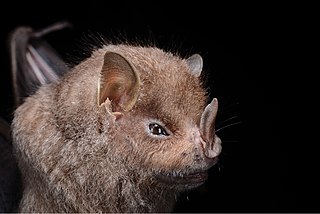Leptophis stimsoni, commonly known as the grey lora or the Trinidad upland parrot snake, is a small species of snake in the family Colubridae. The species is endemic to the Republic of Trinidad and Tobago.
Main Ridge is the main mountainous ridge on the island of Tobago, Trinidad and Tobago. It is a 29-kilometre (18 mi) chain of hills which runs from southwest to northeast between the Caribbean Sea and the Southern Tobago fault system and reaches a maximum height of 572 m (1,877 ft). The Main Ridge Forest Reserve, which was legally established in 1776, is one of the oldest protected areas in the world. It is a popular site for birdwatching and ecotourism. Main Ridge provides important habitat for native plants and animals, including several species endemic to Tobago.
Podocarpus trinitensis is a species of conifer in the family Podocarpaceae. It is endemic to Trinidad and Tobago, where it has only been recorded from the island of Trinidad. It has been recorded from 13 distinct localities in Trinidad, including sites in the Central Range and in central and eastern areas of the Northern Range.
Naufraga balearica is an extremely species of flowering plant in the family Apiaceae, and the only species in the monotypic genus Naufraga. It is endemic to the Spanish island of Majorca, where it is found only at the base of cliffs at the north of the island near Pollença. A population was discovered on Corsica in 1981, but it had died out by 1983, and it is not clear whether it arrived naturally. Its natural habitats are Mediterranean-type shrubby vegetation and rocky shores.

The Guadeloupe big-eyed bat is a species of bat in the family Phyllostomidae. It is found in Guadeloupe and Montserrat. It is threatened by habitat loss mostly because of Hurricane Hugo, which destroyed 90% of the population of this bat in 1989. The species may be locally extinct in some areas of Guadeloupe.
Ficus amazonica is a species of flowering plant in the family Moraceae. It is found in Brazil, Guyana, Trinidad and Tobago, and Venezuela.

Ilex gardneriana is a critically endangered species of plant in the family Aquifoliaceae. It is endemic to the Nilgiri Hills of India.
Pradosia grisebachii is a species of plant in the family Sapotaceae. It is found in Trinidad and Tobago and Venezuela.

Roupala is a Neotropical genus of woody shrubs and trees in the plant family Proteaceae. Its 34 species are generally found in forests from sea level to 4000 m altitude from Mexico to Argentina.
Solanum tobagense is a species of plant in the family Solanaceae. It is found in Guyana, Trinidad and Tobago, and Venezuela.
The endemic flora of Trinidad and Tobago includes a total of 59 species of vascular plants belonging to 34 plant families. This is less than 3% of the total vascular plant flora of Trinidad and Tobago. Thirty-nine of these species are endemic to Trinidad, 12 are Tobagonian endemics, and six are present on both islands.
Dicliptera aripoensis is a species of plant in the family Acanthaceae which is endemic to Trinidad and Tobago. The species is only known from the Heights of Aripo, in Trinidad's Northern Range. It is a branching shrub, 1–1.5 m tall with red flowers about 3 cm long.
Justicia flaviflora is a species of herbaceous plant in the family Acanthaceae. It was previously classified as Beloperone flaviflora. The species is endemic to the island of Trinidad in the Caribbean republic of Trinidad and Tobago where it is only known from near the peaks of mountains in the Northern Range. It is an erect herb with leaves up to 27 cm (11 in) long. It is suffering from habitat degradation and has become increasingly rare, being now rated as "critically endangered".
Justicia tobagensis is a species of plant in the family Acanthaceae which is endemic to Trinidad and Tobago. The species is only known from two areas in the Main Ridge of Tobago. It was first described as Drejerella tobagensis by German botanist Ignatz Urban in his Symbolae Antillanae, based on a collection made by Danish botanist Henrik von Eggers
Odontonema brevipes is a species of plant in the family Acanthaceae which is endemic to Trinidad and Tobago. The species is only known from four localities in the Main Ridge of Tobago. It was described by German botanist Ignatz Urban in his Symbolae Antillanae, based on collections made by Danish botanist Henrik von Eggers and English-born Trinidadian botanist Walter Elias Broadway.

The environment of Trinidad and Tobago reflects the interaction between its biotic diversity, high population density, and industrialised economy.
Duguetia tobagensis is a small tree in the plant family Annonaceae which is endemic to Trinidad and Tobago. The species is only known from Tobago.

Tabernaemontana pandacaqui, known as windmill bush and banana bush, is a species of plant in the dogbane family Apocynaceae.
Halophila baillonis is a species of aquatic plant in the family Hydrocharitaceae. It is referred to by the common name clover grass. It is native to Brazil, Cayman Islands, Colombia, Costa Rica, Jamaica, Leeward Islands, Netherlands Antilles, Panama, Puerto Rico, Trinidad and Tobago, and Venezuela. It is listed on the IUCN Red List as "vulnerable" due to its naturally rare occurrence and fragmented populations.





